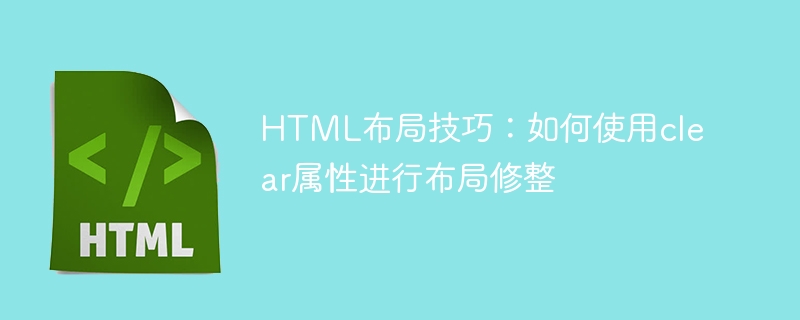Home >Web Front-end >HTML Tutorial >HTML layout tips: How to use the clear attribute for layout modifications
HTML layout tips: How to use the clear attribute for layout modifications
- 王林Original
- 2023-10-18 11:40:462072browse

HTML layout skills: How to use the clear attribute for layout modification
Introduction:
In web development, we often face the problem that the layout of elements does not meet expectations. . Sometimes, when an element is floated, it causes other elements to become misaligned or overlap. To address this problem, we can use the clear attribute for layout modification to ensure that the elements are in the correct position.
1. The meaning of the clear attribute
The clear attribute is used to specify how an element responds to a floating element in front of it. By setting the clear property, we can ensure that an element does not appear on the same line as a floated element before it.
2. The value of the clear attribute
The clear attribute has the following commonly used values:
- none: Default value, the element is not affected by floating elements, and may appear Next to the floated element.
- left: The element will not appear on the same line as a floated element on the left.
- right: The element will not appear on the same line as a floated element on the right.
- both: Elements will not appear on the same line with floated elements on the left and right.
3. Example of using the clear attribute for layout modification
The following is an example of using the clear attribute for layout modification:
<!DOCTYPE html>
<html>
<head>
<style>
.float-left {
float: left;
width: 50%;
background-color: lightblue;
}
.clearfix::after {
content: "";
display: table;
clear: both;
}
</style>
</head>
<body>
<h2>使用clear属性进行布局修整</h2>
<div class="clearfix">
<div class="float-left">这是左侧浮动元素</div>
<div class="float-left">这是右侧浮动元素</div>
</div>
<p>这是其他内容</p>
</body>
</html>In the above code, we first define a A style with class float-left, used to set the width and background color of floating elements. Then, we created a style with class clearfix and used the clear:both attribute in it to correct the impact of floating elements.
Finally, in HTML, we use the clearfix class to wrap the two divs that will be floated.
Please note that our floated elements are 50% width, which means they should be displayed on the same line. If we don't use the clear property for trimming, they will overlap. However, by using the clearfix class, and setting the clear attribute to both, we can ensure that these two elements appear on the left and right sides of the two rows respectively.
Conclusion:
In Web development, using the clear attribute for layout modification is very useful. It can help us solve layout problems caused by floating elements and ensure that elements are displayed in the correct position.
Through the examples introduced in this article, we can clearly understand how to use the clear attribute for layout modification, and observe the changes in the modification effect. I hope this article will be helpful to your layout modification work in web development!
The above is the detailed content of HTML layout tips: How to use the clear attribute for layout modifications. For more information, please follow other related articles on the PHP Chinese website!

